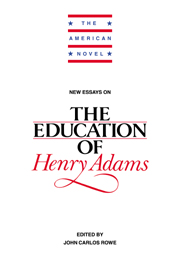Book contents
- Frontmatter
- Contents
- Series Editor's Preface
- 1 Introduction
- 2 The Education of an American Classic: The Survival of Failure
- 3 Being a “Begonia” in a Man's World
- 4 Henry Adams's Education in the Age of Imperialism
- 5 The Education and the Salvation of History
- Notes on Contributors
- Selected Bibliography
- Index
5 - The Education and the Salvation of History
Published online by Cambridge University Press: 15 December 2009
- Frontmatter
- Contents
- Series Editor's Preface
- 1 Introduction
- 2 The Education of an American Classic: The Survival of Failure
- 3 Being a “Begonia” in a Man's World
- 4 Henry Adams's Education in the Age of Imperialism
- 5 The Education and the Salvation of History
- Notes on Contributors
- Selected Bibliography
- Index
Summary
Historians undertake to arrange sequences, – called stories, or histories – assuming in silence a relation of cause and effect.
–Henry Adams, The Education of Henry AdamsStories, or Histories
ThroughoutThe Education of Henry Adams, Henry Adams's incessant search for education is intertwined with a search for history. From the time Adams's first article is accepted in 1867 by the North American Review (222), and especially after he is appointed to the history faculty at Harvard, he frequently meditates on the nature of history and on the office of the historian. These meditations increasingly overlap his preoccupation with acquiring education, and as the book proceeds sometimes history seems the precondition for acquiring education, sometimes education seems the precondition for having an account of history, and sometimes the two endeavors appear virtually indistinguishable. One might justifiably object that education and history need not be so conjoined, but for Adams both undertakings involve the momentous problems The Education so famously engages: whether or not the universe and human affairs exhibit unity; whether humans can apprehend that unity (or its antithesis, chaos).
The enterprises of education and history raise an issue yet broader than whether a particular pattern – unity – exists and is apprehensible. Finally, both involve the phenomenon of narrative. Do nature, past events, and human experience exhibit any pattern – which Adams calls sequence – and can humans discern pattern? This question obviously pertains to the field of history, but education, too, as Adams defines it, requires establishing narrative.
- Type
- Chapter
- Information
- New Essays on The Education of Henry Adams , pp. 115 - 156Publisher: Cambridge University PressPrint publication year: 1996
- 2
- Cited by



